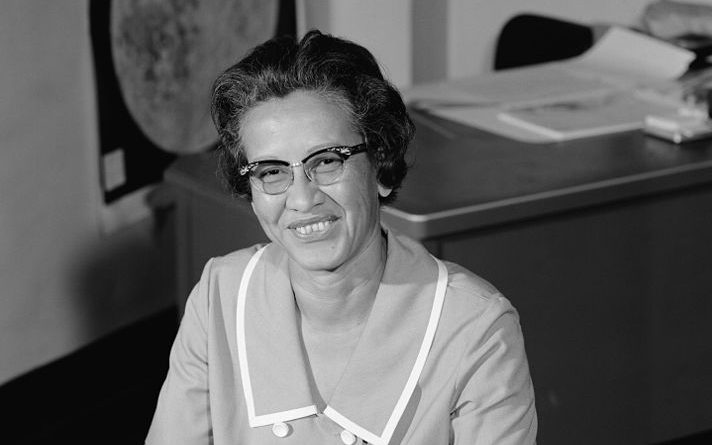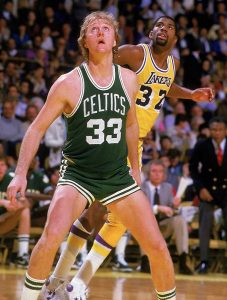Katherine Johnson was approached by one of her friends during a wedding reception in West Virginia in 1953. Her friend mentioned that the Langley Research Laboratories were hiring human computers and that Katherine should check the opportunity out. NACA, or the National Advisory Committee for Aeronautics, was looking for female African-American mathematicians who would be known as “human computers,” who would complete complex mathematical calculations. Katherine loved all of the possibilities that NACA could have in store for her, so she applied, and she moved to Hampton, Virginia with her husband and three children in 1953. Within the year, she had the job at NACA working as a human computer.1
Katherine had always loved math and counting all her life. Anything little Katherine could count, she would, from stairs to the dishes she washed. Katherine was so smart that her first grade teacher sent her up a grade level. As a child, she would always finish her homework first, and then help her siblings with whatever their homework was. She always wanted to understand everything that she could possibly know. Katherine believed that the only dumb questions are the questions that never get asked. She would always raise her hand if she ever had a question. Katherine would never shy away from learning something new.2
Katherine graduated high school at age fourteen and graduated college with the highest honors at the age of eighteen. In college, one of her professors saw her potential and created two different research math courses just for young Katherine. “You would make a good research mathematician,” he told Katherine her sophomore year. “And I am going to prepare you for this career.”3 Math led Katherine to success. All of the help she received as a child and young adult would help her grow and eventually work at NACA and NASA as a female mathematician.
Working at NACA was amazing for Katherine, but working there as an African-American woman came with its own set of challenges to overcome. She and her male coworkers working on similar projects not only had a completely different set of equipment, but they each worked in separate buildings. Katherine was also discriminated against because of her skin color. NACA had segregated bathrooms and a segregated lunchroom. She broke the norms of the time by using whichever restroom was closest to her desk, and by eating at her desk to avoid the lunchroom all together.4 Segregation was still very much alive in Virginia in the 1950s, when she first joined NACA, but this didn’t stop her from achieving amazing things.
Women at the time were not allowed to take part in any of the high level meetings or briefings of the Flight Research Division. Curiously, Katherine didn’t let that stop her: “I’d ask what had gone on in the briefing—I’d listen and listen, and ask questions. Then, of course, I’d ask why I couldn’t go myself, and eventually they just got tired of answering all my questions and just let me in.”5 She did what was unheard of at the time, by being a woman who got into the engineers’ meetings and briefings. Katherine would continue to expand her curious mind and make herself known and respected.
In 1957, four years after she joined NACA, the Space Race between the United States and the Soviet Union started heating up after Sputnik was launched by the Soviets. Katherine was in the perfect spot to expand her knowledge and make herself the best she could be. The National Advisory Committee for Aeronautics soon changed its name to the National Aeronautics and Space Administration or more commonly known as NASA. NASA wanted to do something no one had done before, namely send someone into space. They created Project Mercury. The main mission that Katherine worked on was Mercury-Redstone 3 or Freedom 7.6

Freedom 7 was already decided by NASA: the flight would be short and, would go into space without orbiting the Earth. The flight path would be a parabola that would need to be precise. The space craft needed to land in a specific spot in the Atlantic Ocean where Navy ships would be waiting to retrieve the space craft and the astronaut inside. Katherine was tasked with charting the mission’s trajectory because she had proven herself to be a reliable mathematician and a capable researcher. “Let me do it,” she told the NASA engineers. “Tell me when you want it and where you want it to land, and I’ll do it backwards and tell you where to take off.”7
Katherine figured out what the rocket’s altitude and speed should be in order to reach space and subsequently the splashdown location, all by using analytical geometry.8 On the day of the launch, questions filled the air with everyone wondering if her calculations were correct. Did she do her math right? What would happen if her math was wrong? Would they land in the spot they planned on landing? If this flight didn’t work out correctly, would the United States be out of the space race with the Soviets?
The Freedom 7 rocket obtained a top speed of 5,180 miles an hour and a peak altitude of 116 miles.9 She had done it. Katherine successfully helped send astronaut Alan Shepard into space and brought him safely back to earth. This major success was a big stepping stone for not only Katherine, but for every woman working at NASA. Katherine became a respected mathematician within NASA, not only by other mathematicians, but by everyone involved in her division, the Flight Research Division.10

Katherine became so well known and respected that she was asked to check the new super-computers that were prone to blackouts and hiccups. “But before astronaut John Glenn would launch aboard Mercury’s powerful Atlas rocket, he had a demand for NASA’s leadership: Katherine Johnson needed to review the computations. “If she says they’re good, then I’m ready to go,” he told them.”11 Her brain was capable of completing the same tasks as the computers, but with less error. At times, she was more accurate than the computers.
With all of her knowledge that she contributed to NASA, she was able to write and co-write twenty six NASA research reports in the thirty-three years she had worked there, until 1986.12 She explained, “We wrote our own textbook, because there was no other text about space. We just started from what we knew. We had to go back to geometry and figure all of this stuff out.”13 Katherine helped create a good portion of what NASA and the world knows about space. She was an innovator.
“In 2015, President Barack Obama personally awarded Katherine the Presidential Medal of Freedom. At the ceremony, he stated, ‘In her thirty-three years at NASA, Katherine was a pioneer who broke the barriers of race and gender, showing generations of young people that everyone can excel at math and science, and reach for the stars.’ Indeed, with her perseverance, intelligence, and hard work, Katherine overcame many obstacles and helped take her country—and the whole of humanity—all the way to the moon.”14

Katherine Johnson did so many amazing things during her life time. She sent people to space and brought them safely back. The only way she accomplished so many spectacular things was that she asked questions. She led the way for women in not only NACA and NASA, but in STEM, to explore and create amazing discoveries about the world we live in.
- Joseph Taylor, “The Path to the Moon: The Story of Katherine Johnson,” Cricket, (2019), 19. ↵
- Joseph Taylor, “The Path to the Moon: The Story of Katherine Johnson,” Cricket, (2019), 19. ↵
- Joseph Taylor, “The Path to the Moon: The Story of Katherine Johnson,” Cricket, (2019), 19. ↵
- Joseph Taylor, “The Path to the Moon: The Story of Katherine Johnson,” Cricket, (2019), 19. ↵
- Contemporary Black Biography, Vol. 61, 2007, s.v. “Johnson, Katherine Coleman Globe,” by Margaret Alic. ↵
- Contemporary Black Biography, Vol. 61, 2007, s.v. “Johnson, Katherine Coleman Globe,” by Margaret Alic. ↵
- Contemporary Black Biography, Vol. 61, 2007, s.v. “Johnson, Katherine Coleman Globe,” by Margaret Alic. ↵
- Joseph Taylor, “The Path to the Moon: The Story of Katherine Johnson,” Cricket, (2019), 19. ↵
- Joseph Taylor, “The Path to the Moon: The Story of Katherine Johnson,” Cricket, (2019), 19. ↵
- Margot Lee Shetterly, Winifred Conkling, and Laura Freeman, Hidden Figures: The Ture Story of Four Black Women and the Space Race (Harper, Harper Collins Publishers, 2018), 34. ↵
- Joseph Taylor, “The Path to the Moon: The Story of Katherine Johnson,” Cricket, (2019), 19. ↵
- Margot Lee Shetterly, Winifred Conkling, and Laura Freeman, Hidden Figures: The True Story of Four Black Women and the Space Race (Harper, Harper Collins Publishers, 2018), 23. ↵
- Michael Mink, “Katherine Johnson Did The Math For NASA When It Counted Most,” Investors Business Daily, December 29, 2016. ↵
- Joseph Taylor, “The Path to the Moon: The Story of Katherine Johnson,” Cricket, (2019), 19. ↵




30 comments
Giselle Garcia
This article was very satisfying to read as it applauds Katherine Johnson’s huge contribution to NASA, most notably during the Space Race. I am impressed by her determination despite the discrimination going on at the time, which eventually lead her to succeed in sending astronauts to space, and she became respected by others in NASA. It was interesting to find out that she graduated high school at age fourteen then college at eighteen! She is definitely a genius. It’s inspiring to learn about women in the STEM field who proved they have strong, intelligent minds.
Cynthia Perez
What a wonderful and inspiring article to read about Katherine Johnson. She was an African-American female genius who specialized in mathematics and she defied many gender norms extraordinarily well. It’s amazing reading about people that have exceeded in the most prosperous ways. It’s especially mind blowing that she graduated at the age of fourteen and got the highest honors in college at the age of eighteen. She was meant for excellence and truly dominated her skills and talents in the workforce and life in general. Nice uplifting article that was nicely shared.
Hannah Hennon
It is amazing that a woman was able to partake in figuring out the math for the Freedom 7 rocket. This was a huge step for women in not only this field of math and science, but it is a huge step for women as a whole nation. It is amazing and good that she was recognized for her accomplishment and hard work.
Nelly Perez
I can agree with Katherine that dumb questions are the ones that are never asked. She was really eager to learn and signing up for an impressive job was pretty cool. Her intelligence really amazes me. She graduated high school at 14? That’s crazy! What was sad that there were some downfalls to her work experience. She managed to overcome it with her intelligence.
Thalia Romo
I think this article does a great job at depicting Katherine as the amazing and intelligent women that she was. It’s astonishing how she was so intelligent and was able to acquire a job with NASA. Although this was during a period of segregation, she managed to hold up and remain strong. This article amazed me at just how talented and meant for the job Katherine was since a young age.
Kathryn Martinez
Before reading this article I had some background knowledge about Katherine Jonson. She truly was an inspiring woman not only to women but to people of color as well. Being in the STEM industry is still difficult for women as it is a male-dominated field, however, she pushed back and was able to overcome all. She was able to help the U.S in the space race and was able to help the advancement of colored women in the STEM industry.
Malik Heard
Kathrine Jonson was an amazing person and interesting person.She was able to inspire many with her achievements and fight through the obstacles that held her back to make something out of her self.She led the way for women in her respective field and showed that women can be just as brilliant as men in the field.She proved the people who thought she couldn’t do it wrong and achieved her goal.This article lead us through her struggles and how she overcame them.
Emmanuel Ewuzie
I love space. Outer Space is what really intrigues me which is why I want to get into aeronautics and aerospace engineering. My dream job is working for NASA. I want help design and test rockets and their engines. Katherine Johnson is an inspiration in my eyes due to her great contributions to Space travel. I remember they made a movie about her struggles, Hidden Figures.
Sebastian Azcui
Great article and very interesting! Katherine Jonson, I had no idea who she was until I read this article. She is someone inspiring and did many things. Katherine went through many challenges in her life, specially since she was a colored woman. Engineering, or the STEM is one of the hardest fields of careers that one chooses to study. It has a stereotype that only men have the capcity to do it. But, she demonstrated that women can do it too.
Kimberly Parker
Katherine Jonson was such an intriguing and inspiring woman. This article focuses on the challenges that she faced as a colored woman in the STEM industry, which was and still is, one of the hardest curriculums and thought to be for just men. Katherine and many other women did was prove everyone who thought that way wrong, the moment they went with their brilliant minds and helped the U.S. in the space race.